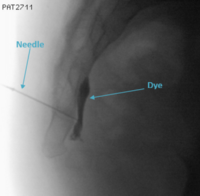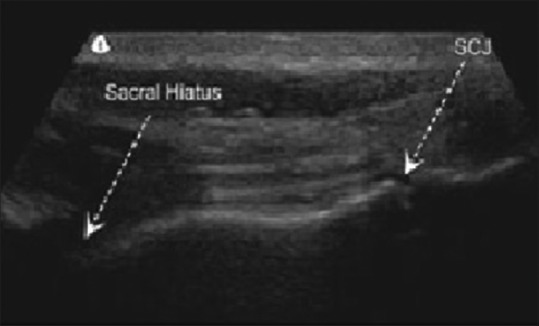Ganglion Impar Injection: Difference between revisions
No edit summary |
No edit summary |
||
| Line 3: | Line 3: | ||
|indication=[[Coccydynia]], chronic prostatitis, chronic proctitis, pelvic malignancies, and chronic perineal pain | |indication=[[Coccydynia]], chronic prostatitis, chronic proctitis, pelvic malignancies, and chronic perineal pain | ||
|syringe=10mL | |syringe=10mL | ||
|needle=23g | |needle=40mm 23g needle | ||
|steroid=40mg | |steroid=40mg | ||
|local=1% lidocaine or 0.25% bupivicaine | |local=1% lidocaine or 0.25% bupivicaine | ||
| Line 9: | Line 9: | ||
}} | }} | ||
Injection treatment of the ganglion impar with local anaesthetic with or without corticosteroid is a procedure to treat [[Coccydynia]], chronic perineal pain, and other conditions. Needle placement is generally done by piercing through the sacrococcygeal disc space. Radiofrequency treatments such as pulsed radiofrequency is a newer technique and may provide better results than blockade.{{#pmid:31652036|sir}} | Injection treatment of the ganglion impar with local anaesthetic with or without corticosteroid is a procedure to treat [[Coccydynia]], chronic perineal pain, and other conditions. Needle placement is generally done by piercing through the sacrococcygeal disc space. A single injection can provide long lasting relief of pain. | ||
Radiofrequency treatments such as pulsed radiofrequency is a newer technique and may provide better results than blockade.{{#pmid:31652036|sir}} | |||
==Anatomy== | ==Anatomy== | ||
| Line 21: | Line 23: | ||
The optimum technique uses a combination of ultrasound and fluoroscopy. Ultrasound uses loss of resistance as the modality can't alone accurately assess needle depth, while fluroscopy alone cannot accurately identify the sacrococcygeal junction nor its angulation due to bowel gas. In the combined technique the needle is first inserted under ultrasound guidance, and then the depth verified by fluoroscopy. This provides optimum accuracy and safety.<ref>{{#pmid:20447308}}</ref> | The optimum technique uses a combination of ultrasound and fluoroscopy. Ultrasound uses loss of resistance as the modality can't alone accurately assess needle depth, while fluroscopy alone cannot accurately identify the sacrococcygeal junction nor its angulation due to bowel gas. In the combined technique the needle is first inserted under ultrasound guidance, and then the depth verified by fluoroscopy. This provides optimum accuracy and safety.<ref>{{#pmid:20447308}}</ref> | ||
===Ultrasound Guided=== | A needle inside needle technique had been described. This uses an initial 1.5 inch 22 gauge needle inserted through the sacrococcygeal junction. A 2 inch 25 gauge needle is placed through the 22 gauge needle. | ||
===Ultrasound Guided Transsacrococcygeal Injection=== | |||
[[File:US sacral hiatus and SCJ.jpg]] | [[File:US sacral hiatus and SCJ.jpg]] | ||
Ultrasound guided techniques have been described such as by Ghai et Al.<ref>{{#pmid:31007658}}</ref> Loss of resistance is used and this appears to be patient and operator dependent. | Ultrasound guided techniques have been described such as by Ghai et Al.<ref>{{#pmid:31007658}}</ref> Loss of resistance is used and this appears to be patient and operator dependent. | ||
*Position: prone, lower limbs internally rotated, toes pointing to the opposite foot. This helps to separate the buttocks and | *Position: prone, lower limbs internally rotated, toes pointing to the opposite foot. Optional pillow under the abdomen to reduce lumbar lordosis. This all helps to separate the buttocks and provide a flatter sacral hiatus site. | ||
*Place the transducer in the transverse position and visualise the sacral hiatus, the two sacral cornuae, and the sacrococcygeal ligament which traverses the sacral hiatus above the epidural space | *Place the transducer in the transverse position and visualise the sacral hiatus, the two sacral cornuae, and the sacrococcygeal ligament which traverses the sacral hiatus above the epidural space | ||
*Obtain a longitudinal position of the sacral hiatus, the proximal portion of the transducer resting between the two cranial sacral cornuae. The first cleft caudal to the sacral hiatus is the sacrococcygeal junction. | *Obtain a longitudinal position of the sacral hiatus, the proximal portion of the transducer resting between the two cranial sacral cornuae. The first cleft caudal to the sacral hiatus is the sacrococcygeal junction. | ||
| Line 36: | Line 40: | ||
===Fluoroscopic Guidance=== | ===Fluoroscopic Guidance=== | ||
[[File:Ganglion impar fluoroscopy.PNG|thumb|left|200px|Fluoroscopic lateral view of ganglion impar block. Courtesy of Sir et al<ref name="sir"/>]] | [[File:Ganglion impar fluoroscopy.PNG|thumb|left|200px|Fluoroscopic lateral view of ganglion impar block, confirmation by the “comma sign” in the retroperitoneal space. Courtesy of Sir et al<ref name="sir"/>]] | ||
<br style="clear:left"/> | <br style="clear:left"/> | ||
;Transsacrococcygeal | ;Transsacrococcygeal Technique | ||
This is the preferred method | This is the preferred method | ||
| Line 52: | Line 56: | ||
==Complications== | ==Complications== | ||
Neuritis, inadvertant injection into the rectum, infection. | |||
==Aftercare== | ==Aftercare== | ||
Revision as of 18:44, 26 July 2020
| Ganglion Impar Injection | |
|---|---|
| Indication | Coccydynia, chronic prostatitis, chronic proctitis, pelvic malignancies, and chronic perineal pain |
| Syringe | 10mL |
| Needle | 40mm 23g needle |
| Steroid | 40mg |
| Local | 1% lidocaine or 0.25% bupivicaine |
| Volume | 3-5mL of 1% lidocaine or 10mL of 0.25% bupivicaine and 40mg of methylprednisolone |
Injection treatment of the ganglion impar with local anaesthetic with or without corticosteroid is a procedure to treat Coccydynia, chronic perineal pain, and other conditions. Needle placement is generally done by piercing through the sacrococcygeal disc space. A single injection can provide long lasting relief of pain.
Radiofrequency treatments such as pulsed radiofrequency is a newer technique and may provide better results than blockade.[1]
Anatomy
The ganglion impair is a midline sympathetic ganglion anterior to the upper coccyx, formed by the caudal termination of paired sympathetic chains. The ganglion provides both sympathetic and visceral innervation to the coccyx, perineum, and anal regions. The size and location can vary, and in some people the ventral ramus of the sacral nerve roots run close by. It is classically at the level of the sacrococcygeal junction.
Indications
Contraindications
Technique
The optimum technique uses a combination of ultrasound and fluoroscopy. Ultrasound uses loss of resistance as the modality can't alone accurately assess needle depth, while fluroscopy alone cannot accurately identify the sacrococcygeal junction nor its angulation due to bowel gas. In the combined technique the needle is first inserted under ultrasound guidance, and then the depth verified by fluoroscopy. This provides optimum accuracy and safety.[2]
A needle inside needle technique had been described. This uses an initial 1.5 inch 22 gauge needle inserted through the sacrococcygeal junction. A 2 inch 25 gauge needle is placed through the 22 gauge needle.
Ultrasound Guided Transsacrococcygeal Injection
Ultrasound guided techniques have been described such as by Ghai et Al.[3] Loss of resistance is used and this appears to be patient and operator dependent.
- Position: prone, lower limbs internally rotated, toes pointing to the opposite foot. Optional pillow under the abdomen to reduce lumbar lordosis. This all helps to separate the buttocks and provide a flatter sacral hiatus site.
- Place the transducer in the transverse position and visualise the sacral hiatus, the two sacral cornuae, and the sacrococcygeal ligament which traverses the sacral hiatus above the epidural space
- Obtain a longitudinal position of the sacral hiatus, the proximal portion of the transducer resting between the two cranial sacral cornuae. The first cleft caudal to the sacral hiatus is the sacrococcygeal junction.
- Confirm the location of the sacrococcygeal junction by pressing with a long forceps under sonographic monitoring.
- Anaesthetised the overlying skin
- Advance a 23 gauge needle through the sacrococcygeal junction using an out of plane technique.
- Advance the needle until a loss of resistance is felt, which indicates that the needle tip is ventral to the sacrococcygeal ligament. Note that this is not always felt, hence the ideal use of combined imaging with fluoroscopy to confirm needle depth. Ultrasound cannot visualise the ventral coccyx
- Inject 3-5mL of 1% lidocaine or 10mL of 0.25% bupivicaine and 40mg of methylprednisolone.
Fluoroscopic Guidance

- Transsacrococcygeal Technique
This is the preferred method
- Original Plancarte Technique
Uses a per rectal finger during the injection.
- Paramedian Approach
Using a curved needle
Non-ultrasound Guided
This is not recommended
Complications
Neuritis, inadvertant injection into the rectum, infection.
Aftercare
Videos
See Also
External Links
References
- ↑ 1.0 1.1 Sir & Eksert. Comparison of block and pulsed radiofrequency of the ganglion impar in coccygodynia. Turkish journal of medical sciences 2019. 49:1555-1559. PMID: 31652036. DOI. Full Text.
- ↑ Lin et al.. Ultrasound-guided ganglion impar block: a technical report. Pain medicine (Malden, Mass.) 2010. 11:390-4. PMID: 20447308. DOI.
- ↑ Ghai et al.. A prospective study to evaluate the efficacy of ultrasound-guided ganglion impar block in patients with chronic perineal pain. Saudi journal of anaesthesia 2019. 13:126-130. PMID: 31007658. DOI. Full Text.


